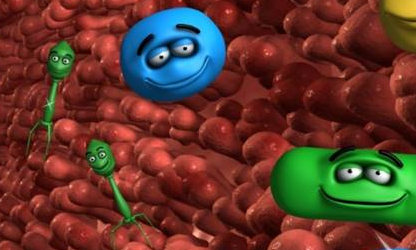

Beating superbugs
January 7, 2002 By Laura Sivitz lsivitz@washtech.com,
After years of research, phage therapy inches closer to market
Two Maryland biotechnology companies and about 10 others worldwide are aiming to defeat bacteria once thought conquered by antibiotics. Applying the latest genetic technology to a decades-old technique, these biotechs hope to put the first modern phage therapy on pharmacy shelves. U.S. patients could benefit as early as 2004, provided the companies can convince reluctant investors to support an experimental drug still unproven in this country.
"It's an area that has to bootstrap its way in," says Dr. Carl R. Merril, one of the National Institutes of Health's principal researchers in phage therapeutics.
Invented eight decades ago in the Soviet Union, phage therapy deploys naturally occurring organisms that feed on bacteria. About a hundred phages could lie end-to-end across the tip of a hair. A phage injects its DNA into a bacterial cell, directing the bacterium to make so many baby phages that the cell bursts. The new phages invade more bacteria and destroy them.
The most near-term phage therapies aim to attack tenacious bacteria that often infect patients in hospitals and long-term care centers. Some 14,000 Americans die annually from hospital-based infections by multidrug-resistant bacteria, and doctors are clamoring for solutions.
The first phage drug could hit the U.S. market in three years if all goes well for Exponential Biotherapies of Rockville. This past spring, it became the first company to complete a human clinical test of a phage drug in the United States, disproving the skeptics who doubted it possible.
Exponential Biotherapies, its competitors and NIH scientists use state-of-the-art gene sequencing and annotation to weed out dangerous phages that code for toxins, antibiotic resistance or other harmful qualities, eliminating problems that plagued phage therapy in the past.
Exponential's drug is designed to fight a strain of bacteria resistant to vancomycin, one of the most powerful antibiotics. Scientists selected phages that stay in the bloodstream much longer than normal, allowing for a 1000-fold smaller dose. "It's always the goal in medicine to give the lowest possible dose," says Richard M. Carlton, the company's president and founder.
His firm holds the exclusive license on this technology for long-circulating phages, which the company developed between 1995 and 1999 with Merril and another phage expert at NIH, Sankar Adhya.
The drug was found safe for healthy volunteers during the week-long test by Exponential, whose lab is in Rockville and administrative office is in Port Washington, N.Y. Now, the 15-person company is improving the quality of its manufacturing process for a bigger experiment to test the drug's efficacy in 100 to 500 patient volunteers. From the stage where Exponential's drug is now, it takes seven years, on average, for a biopharmaceutical to reach the market.
Though investors praise the idea of phage therapy, few have put their money on it. Most prefer to hang back until a precedent-setting phage drug overcomes the many regulatory hurdles to FDA approval.
"Any time you have such an innovative product, you're talking about huge risks," says venture capitalist Wei Wu He of Emerging Technology Partners in Rockville. There are so few experimental phage therapies in the United States that even the Food and Drug Administration has no specific guidance to offer companies wanting to pursue the technology.
But in theory, the lack of precedent wouldn't discourage other venture capital firms like Oxford Biosciences of Boston. "The growth of [antibiotic] resistance has been breathtaking, so we're keenly interested in new technologies " we believe there's a huge opportunity there," says Michael Lytton, a general partner at the firm.
While antibiotics sweep through the body, wiping out a range of bacteria both good and bad, phages are more finicky. Each species of bacteriophage " as it's formally known " consumes only a particular species of bacteria. Although a bacterial strain can grow resistant to a phage attacker, nature constantly invents new phages that overcome their prey.
Still, "It happens we've not looked at these companies" pursuing phage therapy, Lytton says.
If the firm did, it would want a pharmaceutical company to shoulder the capital investment of the biotech's clinical trials, according to Lytton. For that reason, it would choose a biotech that could partner well with a pharmaceutical company.
Intralytix, a young Baltimore biotech pursuing phage therapies, knows venture capitalists' reticence well. The company's biggest challenge? "Raising money," says CEO Torrey C. Brown. A few venture capitalists have committed funds, he says, but he still seeks a lead investor to close the round. His competitor, Exponential Biotherapies, hasn't succeeded at wooing any venture capitalists yet, either.
Both companies have a little money in the bank. Carlton says $3 million remains from the $15 million he's raised from individual investors since 1993, when he founded Exponential. He expects another cash infusion from individual investors in the near future.
Three-year-old Intralytix has raised $2 million to date. The six-person company expects future revenue from phage preparations it's being paid to develop by companies it declined to name for fighting bacterial contamination in agricultural and food products. The new preparations should hit the market next year, says Alexander Sulakvelidze, an Intralytix co-founder and chief scientist.
Those products' sales could partially support the company's work on phage therapies for people. Intralytix applied in September for government clearance to launch animal studies on an anti-VRE phage ? the same bacteria targeted in Exponential's human studies. The Baltimore company is developing another treatment to combat a common, multi-drug-resistant bacterium that infects as many as 80,000 people a year during hospital stays: methicillin-resistant Staphylococcus aureus, or MRSA.
Sulakvelidze says Intralytix could start marketing its first human therapeutic phage treatment as early as 2004 under the best of circumstances. But biopharmaceuticals take 12 years, on average, to progress through animal tests, human tests and the FDA approval process.
Thirty to 40 scientists work for Intralytix on contract at The Institute for Genomic Research in Rockville, the U.S. Department of Agriculture, University of Maryland and elsewhere.
The company is applying to the National Institutes of Health to fund and collaborate on clinical studies. NIH has two experts on phage therapeutics, Merril and Sankar Adhya, who collaborated with Carlton on the long-circulating phage technology he has licensed.
Both Adhya and Merril have researched therapeutic phages for decades. Currently, Merril's lab is developing phages to attack VRE bacteria. Using some of the newest tools to unveil protein structures and sequences, a scientist in the lab recently identified a phage that can kill a broader range of bacterial strains than most. Exponential accomplished a similar feat.
Intralytix hopes to set itself apart with an exclusive, worldwide license on a wound-healing treatment developed by the originators of phage therapy: the Eliava Institute in the former Soviet republic of Georgia. The product, called PhagoBioDerm, is a biodegradable polymer impregnated with a phage cocktail and placed on the skin to treat poorly healing, infected ulcers or to prevent ulcers from forming.
But the FDA wants more detail than is known now about the phages in the cocktail, Sulakvelidze says, and the cocktail must be purer.
Intralytix plans to apply for a small-business innovation research grant from NIH to genetically analyze and purify the phage mixture. PhagoBioDerm will reach the U.S. market in 2007 at the earliest, he says, although it's already sold in the Republic of Georgia.
Published research has reported that bacteria have a harder time evading phage attackers than antibiotics. Some executives, like Brown and Sulakvelidze, say they believe phage therapies will be faster and cheaper to make than antibiotics.
If the entrepreneurs can win funding and FDA approval for a pioneer phage drug, Carlton expects genetically modified versions will come next. "We can anticipate that genetically engineered enhancements will help to realize the full [and vast] potential of phages as antibacterial agents," he says.
© 2001 Post Newsweek Tech Media Group
Cover Image - January, 2002







